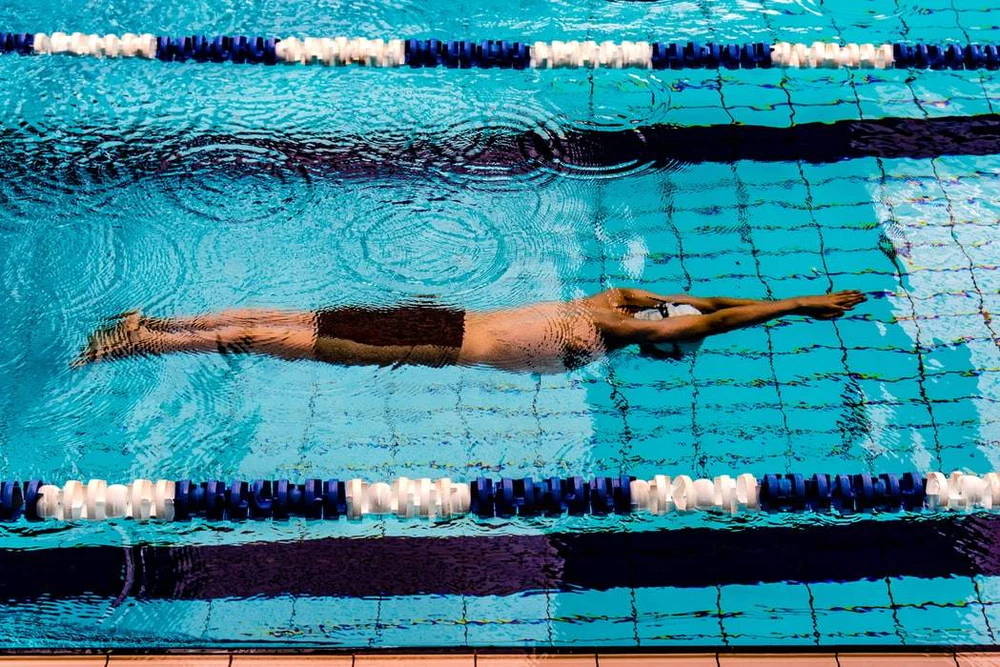Ein Schwimmtraining besteht aus mehreren Teilen und erst die richtige Mischung macht es effektiv. Wir zeigen Euch, wie auch Ihr eine sinnvolle Trainingseinheit im Wasser zusammenstellt und worauf es dabei ankommt.
Aufwärmen und Einschwimmen
Eine Schwimmtrainingseinheit sollte wie jede andere Trainingseinheit mit dem Aufwärmen beziehungsweise Einschwimmen beginnen, um den Körper physisch und psychisch auf die Belastung vorzubereiten.
Zum allgemeinen Aufwärmen kann auch ein entsprechendes Programm an Land dienen, indem durch Laufen, Hüpfen, Armkreisen und leichte Schwung- und Dehnungsgymnastik, die Muskeln und Gelenke auf „Betriebstemperatur“ gebracht werden.
Zum Einschwimmen im Wasser sollten 100 bis 400 Meter in allen Schwimmlagen geschwommen werden.
Tipp von unserem Schwimmtrainer Stephan
"Wichtig ist, von Anfang an den Schalter im Kopf auf Schwimmmodus zu stellen. Das heißt: sobald du das Wasser berührst achte auf die Basics, wie Körperspannung und Streckung. Schludere nicht herum und verfalle nicht gleich in alte Muster."
Schwimme zunächst in moderatem Tempo und wechsle die Lagen. Gegen Ende des Einschwimmens kann die Geschwindigkeit dann etwas ansteigen und leichte Temposteigerungen über 5 bis 10 Meter können eingebaut werden.
Techniktraining
Die Verbesserung der Technik hat beim Schwimmen eine enorme Bedeutung, um sich ökonomisch und schnell fortbewegen zu können. Das Techniktraining ist also ein wichtiger Bestandteil jeder Trainingseinheit. Für die Effektivität ist es besonders wichtig, dass man ohne große körperliche und geistige Ermüdung trainiert, um sich auf die korrekte Ausführung der Übungen konzentrieren zu können. Das Erlernen neuer Technikdetails sollte deshalb immer nach dem Aufwärmen in eine Einheit eingeplant werden.
Kurz und ausgeruht
In der Regel werden mehrere 50 Meter-Serien mit verschiedenen Übungen geschwommen, wobei sich beispielsweise 25 Meter Technikübung mit 25 Meter Gesamtlage abwechseln. Die verschiedenen Übungen haben das Ziel bestimmte Teilaspekte der Gesamttechnik bewusst zu machen und zu verbessern.
Nicht jede für Jeden
Aufgrund der Vielzahl von Technikfehlern ist aber nicht jede Technikübung für jeden Schwimmer geeignet und kann im ungünstigsten Fall sogar die individuelle Technik verschlechtern. Die Auswahl der Übungen sollte also immer sehr gezielt erfolgen und hängt auch davon ab, ob Du Anfänger oder schon ein fortgeschrittener Schwimmer bist. Zudem sollte zwischen den Technikübungen eine kurze Pause sein, um konzentriert und ausgeruht in die nächste Übung zu starten. Wichtig: Es kommt auf gar keinen Fall darauf an hier besonders schnell zu sein.
Hauptteil: Der Inhalt ist entscheidend
Der Inhalt dieses Teils kann je nach Zielsetzung sehr stark variieren. Ziele können die Verbesserung der extensiven (leicht unterhalb der Schwellenleistung) und intensiven (an/über der Schwellenleistung) Grundlagenausdauer, der Schnelligkeit, der Kraftausdauer oder der wettkampfspezifischen Ausdauer sein. Im Gegensatz zum Techniktraining wird die Effektivität des Trainings über eine vorgegebene Intensität (Pulsbereich) erreicht.
Zeit besser als Puls
Die Intensität kann im Schwimmen am besten über Zeitvorgaben gesteuert werden, da es im Gegensatz zum Radfahren oder Laufen kaum äußere Einflüsse auf die Schwimmgeschwindigkeit gibt. Generell erfolgt der Aufbau am besten über Intervalle, das heißt eine bestimmte Strecke wird mehrere Male hintereinander geschwommen. Zwischen diesen Streckenabschnitten erfolgt eine vorgegebene Pause. So fällt es leichter, das Tempo und eine saubere Technik aufrechtzuerhalten.
Pausen- oder Zeitintervalle
Grundsätzlich gibt es zwei Möglichkeiten die Zeitvorgaben für ein Intervalltraining zu gestalten: Das Zeitintervall oder das Pausenintervall. Beim Zeitintervall wird jedes Intervall nach einer bestimmten Zeit wieder begonnen, die Pause hängt also davon ab, wie schnell oder langsam geschwommen wird. Beim Pausenintervall erfolgt nach jedem Intervall eine vorgegebene Pausenzeit, egal wie schnell geschwommen wurde.
Trainingsbeispiele für den Hauptteil
- Ext. Grundlagenausdauer (GA1): 4 x 400m, 3 x 500m, 2 x 800m oder Pyramide mit 100-200-300-400-300-200-100m (Tempo: 65 bis 75 Prozent*)
- Int. Grundlagenausdauer (GA2): 12 x 100m, 6 x 200m (Tempo: 75 bis 85 Prozent*)
- Wettkampfspezifische Ausdauer (WSA): 15 x 100m, 4 x 400m, 1 x 1500m (Tempo: 85 bis 100 Prozent*)
- Schnelligkeit: 2x5x50m oder 2x10x25m (Tempo: >100 Prozent*)
- Kraftausdauer (KA): 6 x 100m, 3 x 200m mit Paddels (Tempo: 75 bis 85 Prozent*)
*der 100m-Bestzeit
Ausschwimmen
Das Ende der Trainingseinheit dient dazu den Körper wieder „herunterzufahren“. Die Atmung normalisiert sich, das Laktat in den Muskeln wird abgebaut und das Ausschwimmen fördert bereits die Regeneration für die nächste Trainingseinheit.
Die Länge kann wie beim Einschwimmen zwischen 100 und 400m betragen, wobei ebenfalls wieder alle Lagen zum Einsatz kommen können. Wichtig ist sich nochmals auf eine saubere Schwimmtechnik zu konzentrieren, um das Training mit einem guten Gefühl zu beenden.
Beispiel-Wochenplan mit 2 Einheiten
- Einheit: Technik + Schnelligkeit + GA2 oder WSA
- Einheit: Technik + GA1 oder KA
Wochenplan mit 3 Einheiten könnte so aussehen
- Einheit: Technik + Schnelligkeit od. WSA
- Einheit: Technik + GA2 od. KA
- Einheit: Technik + GA1
Zugehörige Kategorien





















1 Kommentar
Nicole Geng
Sehr gut und in wenigen Worten präzise erklärt! SUPER 🤩